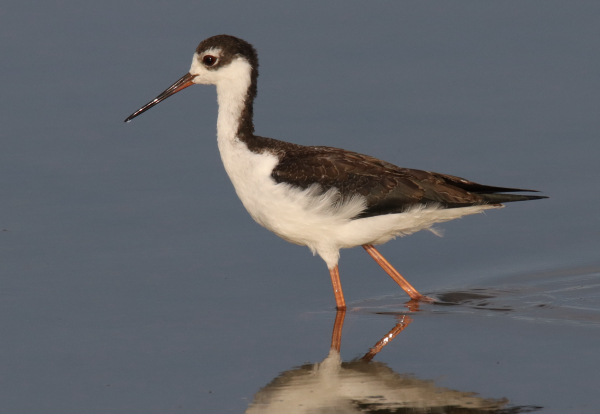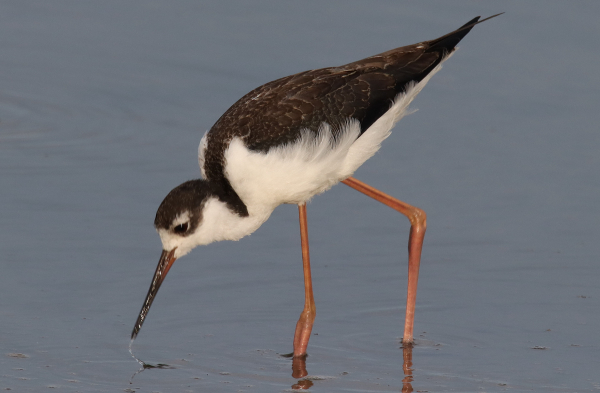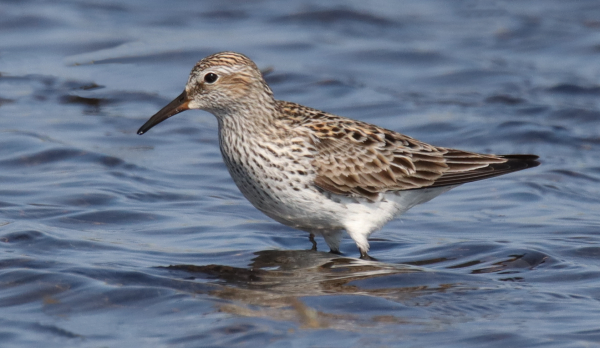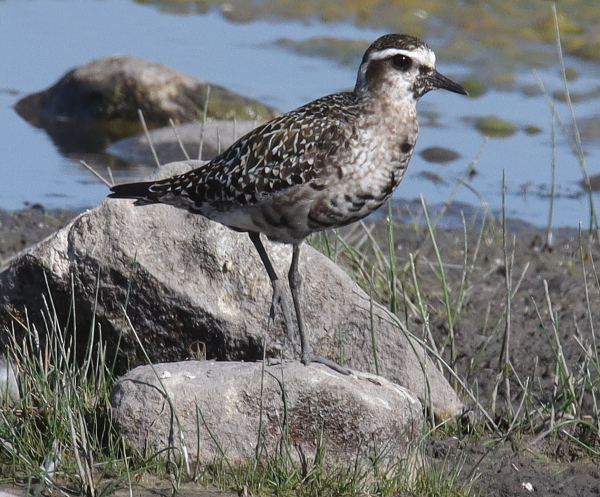
In the field, I thought for sure that the 2 Black-necked Stilts were females, and here’s why: From my vantage point, even with the optical aids of my 600mm camera lens and 8x binoculars, these 2 stilts appeared to lack the lighter colored edge on their black feathers, which is often described as a “scalloped” edge. The lack of scalloped black feathers indicated they were not recent fledglings, but they also were not adult males, which are characterized as having dark-black neck and back plumage. Hence, they were adult females, characterized by a gray-black or brown highlight on their back plumage.
Big Surprise
However, when I returned to my office and reviewed the close, quality photos I was able to take of the stilts as they foraged nearest my position in prime afternoon sunlight, in just a moment I could see my initial take on the age of the stilts during my field observations was not accurate. My enlarged photos showed the black dorsal feathers of both of the stilts had scalloped edges, indicating they were young birds, recent fledglings that probably hatched only 2 months before, and they may have fledged about 1 month ago.

That is a prime example of how definitive photography can be when you have any doubt about the identity, age, or sex of a bird. This kind of detail to accuracy can be personally revealing, and it can change the correctness of a field note, eBird report, or rare bird sighting. There is certainly ample reasoning for requiring a definitive photograph to verify the sighting of a rare bird, such as a first state record or even a North American record, and that all underlines the importance of photography for birders. Every birder should consider a camera with a magnifying lens as a basic part of their birding equipment.
I.D. Aid
Taking a photo or series of photos of a bird can similarly be used to ascertain its species. For example, last spring I was able to become adept at identifying White-rumped Sandpipers in the field after comparing my initial photographs with photos or illustrations in a couple field guides and the Birds of the World website. The small species of sandpipers, the “peeps,” are tough to identify unless you have extended time with them in close quarters, preferably with the opportunity to compare a given species with similar species, like Semipalmated Sandpipers, Baird’s Sandpipers, and Least Sandpipers.

White-rumped Sandpipers are on the larger side of the size range of “peeps” and I learned to watch for their long wings that extend beyond the tail when not in flight. White-rumps have a lighter, whiter look than other peeps in the Central Flyway, showing a mostly white underside with thin brown vertical streaks down their breast and flanks; and their back shows an overall lighter brown coloration on the dorsal side than other small sandpipers. The face of White-rumps is mostly white broken with fine brown streaks, and look for a tan coloration behind the eyes and on the crown of their head with a faint white line above the eye. After making the field-to-photo connection with the White-rumps, and comparing them with other sandpipers, by the second morning of observing a mix of migrating sandpipers I was adept at identifying that species. And that held true even when single White-rumped Sandpipers returned in late summer on their way south to Argentina.
Molting Goldens
The day after documenting the age of the Black-necked Stilts I found at Charo Marsh, during a re-check for the stilts the following afternoon I had a chance to study the mid-molting plumage of some birds I rarely get to see – American Golden Plovers. The 3 Golden Plovers were fairly well “hidden” among a loose flock of about 160 Killdeer, and upon closer inspection through 8x binoculars I could see their molt from alternate to basic plumage was about ¾ complete. They clearly still had an area of black belly feathers and scattered black feathers among the breast and neck plumage of each of the Goldens; in fact, one of the plovers still had many black feathers surrounding its beak.

In this case, I wanted to document my “rare” bird sighting – rare for me in this area – but I was also interested in studying their plumage at this point of their molt, during their long migration from the Canadian Arctic to the mudflats of northern Argentina. That is, if this trio were indeed American Golden Plovers. I was 95 percent sure of that I.D., but there was the slightest chance that these 3 could be Pacific Golden Plovers, or maybe 1 of the 3 could be a Pacific. I wanted to take away any doubt by getting a closer look on the big screen of my laptop computer, where I could enlarge photos to ascertain each plover’s identity 100 percent. My large format check showed they were definitely American Golden Plovers – perfecto.
Distance, optics, perception, experience, and inexperience can all enter into an I.D. in the field that can be double-checked, improved upon, or changed after taking a closer look at a definitive enlarged photograph on a big screen. This practice also helps you see some fine details of birds’ profiles and colors that will help you gain experience with new or rarely encountered species. As fall migration progresses, you will probably find yourself in similar experiences to the ones I’ve described here, potentially with a variety of birds. Enjoy the process, and use the process to become a better birder by utilizing your camera. We all become better birders each time we spend time among birds!
Article and photographs by Paul Konrad
Share your bird photos and birding experiences at editorstbw2@gmail.com